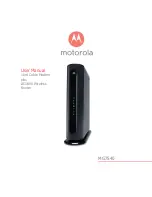
Quantum and Evolution Series Installation and Operating Handbook
8-15
maintained. In effect if two timeslots were dropped from T1-D4 and T1-ESF bearers with
RBS support enabled, although the aggregate data rate would be only 128kbps plus 6.7%
overhead, the frame and multiframe structure would be as to support N=24 and N=48
respectively (N x 12 for D4, and N x 24 for ESF as D4/ESF have 12/24 frames per
multiframe, relative to which RBS is placed). As with the support for `Odd values of N`, the
CAS Multiframe is again used to provide support for these extended timeslot sets, and
hence support the Robbed Bit Signalling.
CAS Multiframe
Intelsat have defined a satellite CAS Multiframe to allow Channel Associated Signalling to
be transferred across the satellite link between E1 PCM bearers within the IBS satellite
overhead. The modem equipped with the Extended D/I feature uses the CAS Multiframe
definition to support CAS, and also to provide Timeslot ID Maintenance for `Odd values of
N` (N = 7, 9, 11, 13, etc), which in turn allows the Modem to also support Robbed Bit
Signalling (RBS). The CAS multiframe is entirely independent of the TS32 Multiframe that
has already been described.
The CAS Multiframe consists of data and frame alignment words in TS16 and TS48 of the
IBS frame. A CAS multiframe starts off as a unique word of [00001y11] in TS16, and
comprises a further 15 signalling data timeslots in TS48 & TS16 stretching over 8 frames.
When carrying CAS, the 15 signalling data timeslots carry pairs of the `abcd` signalling
nibbles from the terrestrial TS16. When not carrying CAS but where the CAS Multiframe
format is being used for solely for timeslot ID maintenance for `Odd values of N`, these 15
signalling data timeslots are available for the high rate ESC.
Similar to the `fitting` of the main data into the 60 timeslots available for data per IBS frame,
the `abcd` signalling information has to be `fitted` into the 30 available nibbles in the 15
signalling data timeslots in TS16 / TS48 following the CAS MF unique word in TS16. There
are certain values of `N` for which this will work, ie where 30/N gives an integer. These
include N =
1, 2, 3, 5, 6, 10, 15, 30
. In these cases then the CAS multiframe is 8 frames in
duration with the first frame containing CAS-MF unique word in TS16 and pairs of `abcd`
signalling nibbles in TS48, and the following seven frames contain pairs of `abcd` signalling
nibbles in TS16 and TS48.
For values of N which are not supported by an 8 frame CAS multiframe (with room for 30
nibbles of signalling), the multiframe is simply extended in length by multiples of 8 frames
until it reaches a value where it can accommodate an integer multiple of the signalling
information in one multiframe. Although the multiframe is extended in multiples of 8 frames
giving a further 30 locations to carry signalling each 8 frames, the CAS-MF unique word is
not repeated but is instead replaced by a [00000000] pack byte in TS16 of every eighth
frame after the original CAS-MF unique word. This keeps the same ratio of 30 signalling
nibbles every 8 frames, no matter how long the CAS multiframe actually is.
The CAS Multiframe structure is of variable length (in multiples of 8 frames), and this
feature lends itself to providing timeslot ID Maintenance for `Odd value of N`, ie values
which the fixed length TS32 multiframe cannot accommodate. This is an efficient use of the
overhead as when not sending signalling information 15 out of every 16 TS16/TS48
locations are still available for high rate ESC, even when the CAS multiframe is required to
support `Odd values of N` or Robbed Bit Signalling.
















































